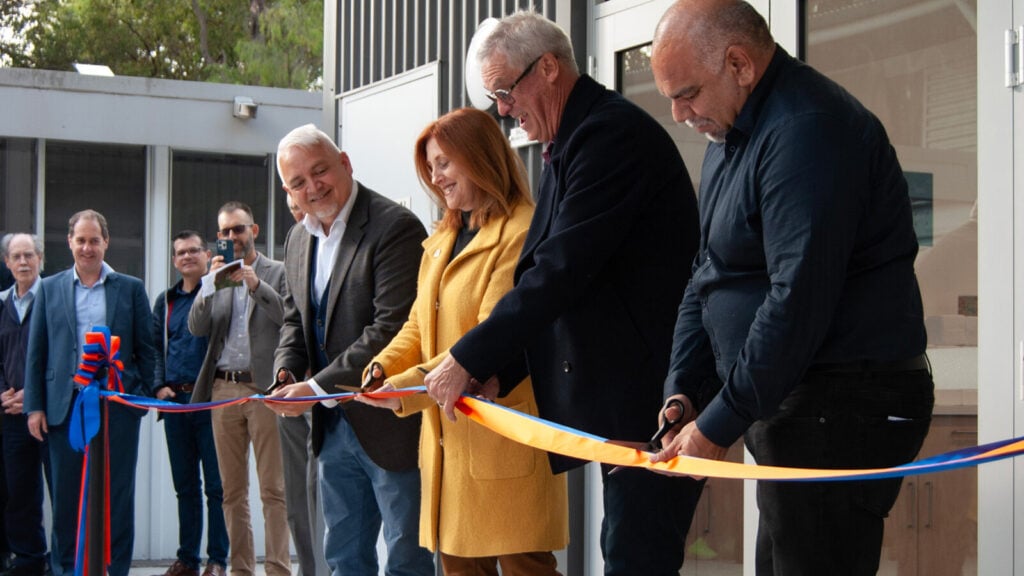WHERE WE ARE

During Reconciliation Week (May 30, 2023), Australian Union Conference (AUC) officers, Aboriginal and Torres Strait Islander Ministries (ATSIM) representatives, and the honorable Mayor of Armadale met to celebrate the opening of a new building and extension to Mamarapha College on Whadjuk Noongar land (also known as Karragullen in Western Australia).
Coming in under budget—at just under $A2 million—the pristine new classrooms, student common area, computer lab, administrative offices and Faith FM recording studio will support growth in First Nations ministry and health education at Mamarapha College.
Teeharnee Robinson, a current ministry student, shared, “I expected to learn about the Bible at Mamarapha, but I never expected the experience to be life changing! I never expected to be speaking in front of a mic in front of you today, and I never expected to have opportunities to travel like I have.”
More than a Bible college, this landmark Registered Training Organisation (RTO) offers accredited courses to support real work opportunities and human flourishing for its Aboriginal students. “I would love to be a chaplain and work with kids some day,” Ms Robinson said.
Pastor Connie Toga, Ministry Course Coordinator at Mamarapha, said, “The new spaces have already given a great boost to student morale, as they have been designed with our students in mind—right down to the carpet colour. The buildings have also led to greater recognition that there are church leaders and members lending support to students who want to be equipped to minister to their own people.”
Pastor Darren Garlett, ATSIM director for the Adventist church in Australia, said, “The Mamarapha experience has been raised even higher. The new buildings represent how much we value the work of Mamarapha College, its students and—more broadly—First Nations ministry.”
Pastor Terry Johnson, AUC President, shared in his dedication speech the importance of Christians leading the way in repairing our relationships with First Nations people: “Central to the Christian message, is Jesus’ work of reconciliation which began here on earth. While our church has formally apologised to Aboriginal and Torres Strait Islander nations after the Bringing Them Home investigation into institutions and the stolen generations, and while we are seeing great things at Mamarapha here today—the work of reconciliation has just begun.”
Pastor Garlett reminds the Adventist church, “Our hope for continued reconciliation with First Nations people is in the hands of our membership. It’s up to local churches to lead in practical ways such as improving understanding and connecting with their local indigenous communities. It’s important that our leadership lead—not only in word—but in actions that affirm our Adventist church’s commitment to reconciliation.”
Pastor David Garrard, principal at Mamarapha College, is excited for the new ministry opportunities within the space: “The new Faith FM studio will allow us to provide spiritual content in both English and Aboriginal languages.”
He continues, “We are currently working in partnership with another RTO to deliver a Certificate II in Community Services. We aim to add this vocational course in 2024, then progress to the Certificate III.”
According to AUC secretary Pastor Michael Worker there are plans to add new courses to broaden the impact and influence of the College throughout First Nations communities, including vocational trade qualifications.
New additions to the site include a unique two-part mural, which tells a story. Dana Garlett, a professional Whadjuk Noongar artist, explains that the story depicts a student’s journey, beginning in darkness on the left (dark burgundy area), moving towards God’s light and the eternal hope of Jesus’ glorious Second Coming on the right (orange and yellow areas). The blue river represents Jesus—the ‘River of Life’—who is ever-present throughout the journey. Also, the leaves represent continual healing and health that comes from God as He heals the brokenness in lives. (The word ‘Mamarapha’ means ‘God heals’ or ‘God makes whole’. ‘Mama’ is the word for ‘God’ for the Western Desert indigenous people. ‘Rapha’ is a Hebrew word for ‘healing’/’making whole’.)
Dark burgundy area: The Holy Spirit impresses upon individuals even as they sit in darkness. The Holy Spirit is represented by the ripples and rings around the people, which are the ‘U’ shaped symbols.
Light burgundy, brown and gold areas: The people gather at Mamarapha and are equipped with knowledge and tools for ministry.
Green and teal areas: As people continue with Jesus, they are further transformed by Him as their relationship with Him grows. This transformation is represented by the changing colour of the individuals throughout the murals. Individuals are equipped with tools for ministry, represented by the ‘U’ and ‘I’ shapes that are together. The white rays coming from some of the individuals are the ‘dhari’ iconography in Torres Strait Islander culture. Individuals with crosshatching surrounding them represent those living in coastal and urban areas. Individuals with the dots and lines represent those living in remote and rural areas.
Teal above the stairs: Fishing nets are also a tool, used to follow Jesus’ instruction to become fishers of men.
Orange and yellow: New meeting places are formed by those who have become agents of change, teaching their own people about Jesus. Figures holding tools at the end of the mural are represented in the same blue as the River. It is God’s desire that we imitate Him, being totally committed to the eternal hope of Jesus, and eternal life with Him.
Join our community and stay informed with the latest developments from the Australian Union Conference of the Seventh-day Adventist Church. Receive updates on news, events, and inspirational stories that matter to you.
Dr Jean Carter has accepted the position of head of School of Education and Science at Avondale University. She is currently serving as national director of...
In his final report as CFO before retirement, Peter Cameron presented a positive picture of the financial health of the Australian Union Conference (AUC) of...
Encouraging church membership growth figures were presented in the secretary’s report on the second day of the Australian Union Conference’s constituency...